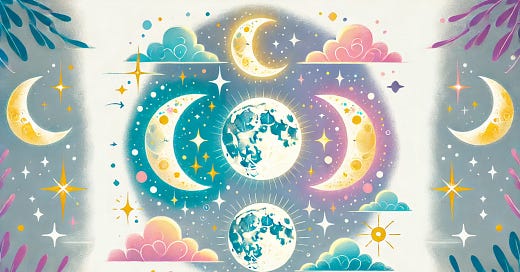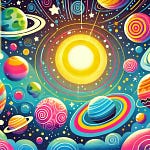Why Does the Moon Change Shape?
In this article, we’re going to learn all about why the moon changes its shape in the sky, what causes it to look different from night to night, and how it is connected to the Earth, the sun, and the way we see things from the ground. Let’s dive in!
Hello my friends!
For a quick note, welcome to Tidbits with Titus, a podcast and newsletter where we tackle the big, curious questions kids ask every day in fun, bite-sized ways! I’m Alexander Titus, but I go by Titus. I’m a scientist, adventurer, and a huge fan of making science, technology, and life accessible to all ages. From “How does electricity work?” to “What are taxes?” and even “Why is the sky blue?” I’m here to dive into these wonder-filled questions with engaging stories and simple explanations that spark curiosity and make learning a joy. This effort is all about creating a space where families can learn together, discover the magic of the every day, and find thoughtful ways to explore the world’s big mysteries. Let’s make curiosity a family tradition—one tidbit at a time!
Just so you know, these podcast episodes are all AI-generated using Google’s really cool NotebookLM technology. That means there are some errors in how words are said, but that is part of the fun!
If your little ones have questions that you want help answering, shoot me an email at questions@tidbitswithtitus.com and I’ll see what I can do!
You can subscribe to the newsletter that has this information as well at tidbitswithtitus.com.
Also please share with anyone you think would be interested. The more the merrier!
Cheers,
-Titus
1. What Is the Moon?
Before we can understand why the moon changes shape, let’s talk a little bit about what the moon really is. The moon is a rocky satellite that orbits (or travels around) the Earth. It’s the Earth’s closest neighbor in space and is about 238,855 miles away—about 30 times the Earth’s diameter! Even though the moon looks bright and shiny in the sky, it doesn’t make its own light. Instead, the moon reflects the light from the sun, which is why we can see it at night.
The moon is about a quarter of the size of the Earth. It has mountains, valleys, craters, and plains on its surface, but it doesn’t have any water, plants, or life. Unlike Earth, the moon has no air, so there’s nothing to protect it from space. But despite all of this, the moon is a very important part of our solar system and plays a big role in the Earth’s tides and even our daily lives.
Now, let’s get back to the question at hand: Why does the moon change shape? The answer has to do with how the moon moves around the Earth and how we see it from our point of view on the ground.
2. The Moon’s Phases
The moon doesn’t actually change its shape. What’s really happening is that it goes through a cycle of different phases. These phases are different stages in the moon’s orbit around the Earth. The phases happen because of how the moon, Earth, and the sun are positioned in space.
As the moon orbits the Earth, it only gets part of its surface lit up by the sun. The side of the moon that faces the sun is bright, while the other side is in shadow. Because the moon is constantly moving around the Earth, the part of the moon that we can see from Earth changes over time. This is what causes the moon to look like it’s changing shape.
Let’s take a closer look at the different phases of the moon and how they happen.
3. The Phases of the Moon
The moon’s phases happen in a cycle, starting with the New Moon and going all the way back to the New Moon again. This cycle takes about 29.5 days—about a month! Here’s how the phases go:
1. New Moon:
The new moon is the first phase in the cycle. During the new moon, the moon is between the Earth and the sun. This means that the sun’s light is shining on the back of the moon, and the side of the moon facing us is completely dark. So, we can’t see the new moon at all. It’s invisible from Earth!
2. Waxing Crescent:
After the new moon, we move into the waxing crescent phase. The word "waxing" means that something is growing or getting bigger. During this phase, a small sliver of the moon starts to show up in the sky. The lighted part is only a small crescent shape, like a tiny smile in the sky.
3. First Quarter:
Next, we have the first quarter phase. The moon has moved a little farther in its orbit, and we can see half of the moon’s surface lit up. This is called a “half moon” because it looks like a half circle. It’s not exactly a full half, but it’s close! The first quarter moon happens about a week after the new moon.
4. Waxing Gibbous:
As the moon continues its orbit, more of it becomes lit up. The next phase is called the waxing gibbous. “Gibbous” means that the moon is more than half-lit, but it’s not yet a full circle. The moon looks almost full, but there’s still a little bit of shadow on one side.
5. Full Moon:
The full moon is when the moon is on the opposite side of the Earth from the sun. This means that the entire near side of the moon is fully lit up by the sun. The full moon looks like a perfect circle in the sky. It’s the brightest phase of the moon and the one we see most clearly.
6. Waning Gibbous:
After the full moon, the moon starts to move back toward the new moon. The next phase is the waning gibbous. The word “waning” means that something is getting smaller or shrinking. In this phase, the light on the moon begins to shrink, and we can see less and less of the moon.
7. Last Quarter:
The last quarter phase is the next phase after the waning gibbous. Just like the first quarter, we can see half of the moon’s surface. But now, the other half of the moon is lit up compared to the first quarter. This is another “half moon,” but the opposite side is bright.
8. Waning Crescent:
The last phase is the waning crescent. In this phase, only a small sliver of the moon is lit up, and it gets smaller and smaller each night. Soon, the moon will disappear again, and we’ll start the cycle all over with the new moon.
The moon’s phases happen in a repeating cycle. As the moon orbits the Earth, we see different amounts of the moon’s surface being lit up by the sun. That’s why the moon seems to change shape over the course of a month.
4. Why Do We See Different Phases of the Moon?
Now that we know about the phases of the moon, you might be wondering: Why do we see different phases at all? The answer has to do with the positions of the moon, the Earth, and the sun.
When the moon is between the Earth and the sun (New Moon): The side of the moon that is facing the sun is fully lit up, but the side facing Earth is in shadow, so we don’t see the moon.
When the moon is on the opposite side of the Earth from the sun (Full Moon): The side of the moon facing Earth is fully lit up, and we see the entire moon shining brightly in the sky.
When the moon is between the new moon and the full moon: We can see a growing portion of the moon, and it changes from a thin crescent to a larger, almost-full shape.
When the moon is between the full moon and the new moon: The moon starts to shrink in size, and we see less and less of it each night.
This is all because of how the moon orbits around the Earth and how the sun’s light shines on different parts of it. The moon doesn’t actually change shape, but the way we see it from Earth makes it look like it does.
5. Fun Facts About the Moon
The Moon is Always Half-Lit: No matter what phase the moon is in, half of the moon is always lit up by the sun. We just can’t see the other half when it’s hidden from our view on Earth.
The Moon’s Gravity Affects the Earth: The moon’s gravity is so strong that it causes the ocean tides on Earth. The pull of the moon creates high and low tides in the oceans as it orbits our planet.
The Moon Has No Atmosphere: The moon doesn’t have an atmosphere like the Earth, which means there’s no air, wind, or weather. This is why the moon’s surface is covered with craters and dust.
The Moon Is Slowly Moving Away: Did you know that the moon is slowly moving away from the Earth? It moves about 1.5 inches (3.8 cm) farther away from Earth every year. But don’t worry! It’ll take millions of years before the moon moves far enough away to affect life on Earth.
We Only See One Side of the Moon: Because the moon rotates at the same rate that it orbits the Earth, we always see the same side of the moon. The other side is called the “far side,” and it was first seen by astronauts when they flew around the moon!
6. Conclusion
The moon may seem to change shape, but it’s really just going through a cycle of phases. As the moon orbits around the Earth, the sunlight shines on different parts of it, making it look like it’s growing and shrinking in the sky. The moon has eight main phases, from the New Moon to the Full Moon, and this cycle repeats every month.
So, the next time you look up at the moon, remember that it’s not changing shape—it's just going through its phases, thanks to the way it moves around Earth and how we see it from the ground!













Share this post